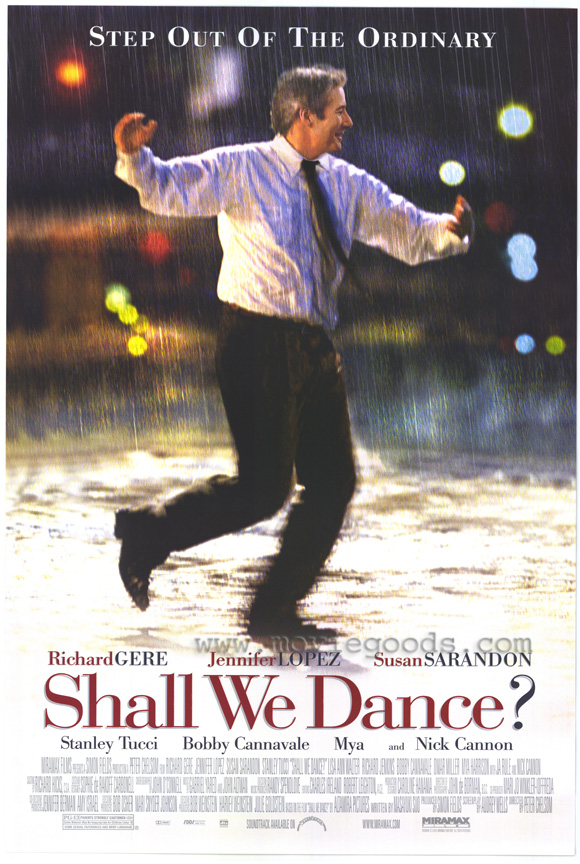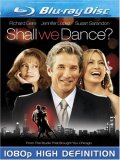| Reviews & Columns |
|
Reviews DVD TV on DVD Blu-ray 4K UHD International DVDs In Theaters Reviews by Studio Video Games Features Collector Series DVDs Easter Egg Database Interviews DVD Talk Radio Feature Articles Columns Anime Talk DVD Savant Horror DVDs The M.O.D. Squad Art House HD Talk Silent DVD
|
DVD Talk Forum |
|
|
| Resources |
|
DVD Price Search Customer Service #'s RCE Info Links |
|
Columns
|
|
|
Shall We Dance (2004)
Happily, Shall We Dance is actually pretty good. Though it makes a few unwise changes, it follows the original film quite closely, even down to a few individual shots, as well as the feel of the score accompanying the film. Most importantly, it retains all of the original film's attributes and its central theme: the joy of ballroom dancing and the beauty of its grace as an instrument toward self-fulfillment. Ironically, Lopez is perfectly fine while Gere, though he tries hard, is miscast.
The Blu-ray disc looks good though like a lot of recent Blu-ray titles its release now at this critical juncture in the format's history is a real head-scratcher. Though it does justice to John de Borman's (The Full Monty) warmly-colored cinematography, one has to wonder why Miramax would think Blu-ray consumers would be clamoring for this, a picture that flopped domestically and that doesn't especially stand apart from standard DVD.
That's no marionette - that's Richard Gere, star of Shall We Dance
Chicago-based estate attorney John Clark (Gere) is married to working wife Beverly (Susan Sarandon) and they enjoy an upper middle-class life with their two teenage children. But something is missing in Clark's life, their relationship has stopped moving, and on his commutes home from work aboard The "L" he gradually becomes obsessed with a young woman, Paulina (Lopez), staring out the window of a ballroom dance school adjacent to the tracks.
Unknown to his wife, he begins taking lessons hoping to meet her. Instead, he's stuck in a beginner's class with older, alcoholic Miss Mitzi (Anita Gillette), owner of the struggling school. But, gradually, he comes to enjoy his lessons, even after Paulina urges him to quit if he's not in it for the dancing. He becomes friends with fellow neophytes Chic (Bobby Cannavale), who supposedly wants to learn ballroom as a means of picking up women; and Vern (Omar Benson Miller), a towering, overweight young man wanting to impress his fiancée.
Clark later becomes friendly with another teacher - abrasive and abusive dance addict Bobbie (Lisa Ann Walter), and eventually Clark learns that one of his co-workers, Link Peterson (Stanley Tucci), is practically living a double life as a dancer, the bald and wiry Link ludicrously trying to look hip in a long wig and tight mamba clothes. Meanwhile, Beverly begins to wonder if perhaps her vaguely dissatisfied husband is having an affair.
Shall We Dance (there's no "?" in the title, unlike the Japanese release, Shall We dansu?) follows the original film's story quite closely, with some changes made for cultural reasons. The American version, for instance, plays up the stereotype that all male dancers are presumed gay, with Link concerned others will misread his sexual orientation. That wasn't really an issue in the Japanese version as gay men are much more widely accepted into mainstream society. Overstated in the supplements is this idea that the touchy-feely aspects of ballroom dancing is Taboo (with a capital "T") in Japan, and that this was altered somewhat for the American version where dancing schools are everywhere. That's not entirely accurate; there's even a popular variation of Dancing with the Stars on Japanese television presently.
The biggest difference between the Japanese film and its American remake is in Susan Sarandon's character, who in the Japanese film was a typical stay-at-home wife. (Many Japanese women work, but most middle-aged women married to higher-income salarymen do not.) Sarandon's character is a working woman, and the couple's inability to share quality time together is one of the reasons for Clark's unhappiness. Fair enough, but the film spends way too much time with her character at the expense of other stuff, especially when the film should be sticking to Clark's perspective pretty much throughout, as the Japanese version had. What's missing here is that there's not enough footage showing Clark, Chic, and Vern slowly improving their dancing through hard work. In the remake, they become too graceful too quickly.
The main problem with Richard Gere is that he can't quite shake his screen persona. Clark is supposed to be a relatively shy man, supremely uncomfortable and awkward trying to learn how to dance. The payoff, of course, is when he starts gaining confidence which spills out into his everyday life. The problem is Gere's screen persona already exudes confidence; in his most famous films he was the quietly confident character while his female co-stars were the ones racked with self-doubt. As a result, instead of this character becoming an identifiable everyman all men can relate to, Gere almost comes off like a spy infiltrating the dance studio for some unknown reason. He's just not one of us mortals. Gere's a good enough actor that he almost makes the character work, but not quite.
Similarly, the writing and Gere's performance extinguish any suspense that Clark might abandon his wife and family for the exotic Paulina. That didn't seem particularly likely in the Japanese version either, but here too much of Clark's home life is shown and what we see would seem idyllic for most audiences: happy family, comfortable home in the suburbs, lots of money to go around. The idea expressed in Audrey Wells' script is that Clark feels guilty that he's unhappy in spite of everything, but it's another idea that just doesn't come off.
Lopez is fine in a less-demanding role; her character is less emotionally aloof than the archly-conceived one in Masayuki Suo's original film (which he wrote and directed). Predictably, the American version can't resist including a few incongruous hip-hop type songs; the Japanese version stuck to more classical pop standards like the title tune (from The King and I). But, thankfully, American screenwriter Wells doesn't try to retool Lopez's character into a dirty dancer; she's essentially the same character as in the original film and to Lopez's credit she pulls it off.
Video & Audio
Filmed for 1.85:1 on Fuji stock with theatrical prints by De Luxe, Shall We Dance is presented here in 1.78:1 widescreen (not 1.85:1 as stated on the box). The 1080p high-def image is fairly strong; the film leans heavily on oranges, reds, and greens, and much of the film is set on nighttime city streets and the like, all of which are reproduced with strong color, good contrast and sharpness.
Menu screens are in English, French, Spanish, and Portuguese, with subtitles and audio in Dolby Digital 5.1 English SDH, French, and Spanish. A 5.1 uncompressed track (48kHz/24-bit) is also included, though the screenplay doesn't lend itself well to aggressive mixing. Benefiting mainly is the song- and underscoring-heavy soundtrack.
Extra Features
All of the extras, all in 480i standard-def, are carryovers from the 2005 standard DVD release, and everything is 4:3 full frame and with 4:3 letterboxed clips. Behind the Scenes of Shall We Dance? (sic) runs 24 minutes and is the usual featurette-cum-extended commercial; its major asset is that it includes clips from the Japanese film.
Beginners' Ballroom (6 1/2 minutes) hints at the Hell the cast endured learning this masochistic quasi-sport from professional dancers. It's interesting and informative. Much less so are two more promotional tools: The Music of Shall We Dance?, which tries to justify the overuse of contemporary music in a film best without such material, and the illustrative Pussycat Dolls "Sway" Music Video, which has about as much to do with the spirit of Shall We Dance as a commercial for canned peas.
Finally, director Peter Chelsom (the interesting, underrated Funny Bones) offers an above average, intelligent audio commentary, carried over optionally in the 17 minutes worth of deleted scenes. The cut footage was rightly excised but much of it, particularly a visually interesting but completely inappropriate title sequence, is worth checking out.
Parting Thoughts
Though not quite up to the level of the film that inspired it, Shall We Dance is pretty good on its own terms. It respects and understands what made the original version work, and generally does a good job adapting the material to an American setting, though it has its share of missteps, too. All in all, this is a much better film that those familiar with the original would have anticipated, and the Blu-ray offers a fine picture and sound, if nothing new in terms of extra features. Recommended.
Film historian Stuart Galbraith IV's latest books, Japanese Cinema and The Toho Studios Story, are now available for pre-order.
|
| Popular Reviews |
| Sponsored Links |
|
|
| Sponsored Links |
|
|
| Release List | Reviews | Shop | Newsletter | Forum | DVD Giveaways | Blu-Ray | Advertise |
|
Copyright 2024 DVDTalk.com All Rights Reserved. Legal Info, Privacy Policy, Terms of Use,
Manage Preferences,
Your Privacy Choices | |||||||













